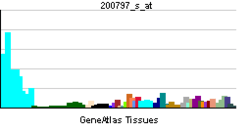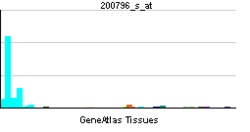MCL1
Induced myeloid leukemia cell differentiation protein Mcl-1 is a protein that in humans is encoded by the MCL1 gene.[1][2]
Function
The protein encoded by this gene belongs to the Bcl-2 family. Alternative splicing occurs at this locus and two transcript variants encoding distinct isoforms have been identified. The longer gene product (isoform 1) enhances cell survival by inhibiting apoptosis while the alternatively spliced shorter gene product (isoform 2) promotes apoptosis and is death-inducing.[3]
Clinical significance
Omacetaxine mepesuccinate and Seliciclib [4] as an investigational treatment for chronic myelogenous leukemia (CML) and multiple myeloma respectively, act by inhibiting synthesis of Mcl-1.
Interactions
MCL1 has been shown to interact with:
- BAK1,[5][6][7][8]
- BCL2L11,[8][9][10]
- BID,[7][9]
- BAD,[9][11]
- DAD1,[12]
- PMAIP1,[6][9]
- PCNA,[13] and
- TNKS[14]
See also
References
- ↑ Kozopas KM, Yang T, Buchan HL, Zhou P, Craig RW (May 1993). "MCL1, a gene expressed in programmed myeloid cell differentiation, has sequence similarity to BCL2". Proc Natl Acad Sci U S A 90 (8): 3516–20. doi:10.1073/pnas.90.8.3516. PMC 46331. PMID 7682708.
- ↑ Craig RW, Jabs EW, Zhou P, Kozopas KM, Hawkins AL, Rochelle JM et al. (February 1995). "Human and mouse chromosomal mapping of the myeloid cell leukemia-1 gene: MCL1 maps to human chromosome 1q21, a region that is frequently altered in preneoplastic and neoplastic disease". Genomics 23 (2): 457–63. doi:10.1006/geno.1994.1523. PMID 7835896.
- ↑ "Entrez Gene: MCL1 myeloid cell leukemia sequence 1 (BCL2-related)".
- ↑ MacCallum DE, Melville J, Frame S, Watt K, Anderson S, Gianella-Borradori A et al. (2005). "Seliciclib (CYC202, R-Roscovitine) induces cell death in multiple myeloma cells by inhibition of RNA polymerase II-dependent transcription and down-regulation of Mcl-1". Cancer Research 65 (12): 5399–5407. doi:10.1158/0008-5472.CAN-05-0233. PMID 15958589.
- ↑ Leu JI, Dumont P, Hafey M, Murphy ME, George DL (May 2004). "Mitochondrial p53 activates Bak and causes disruption of a Bak-Mcl1 complex". Nat. Cell Biol. 6 (5): 443–50. doi:10.1038/ncb1123. PMID 15077116.
- ↑ 6.0 6.1 Willis SN, Chen L, Dewson G, Wei A, Naik E, Fletcher JI et al. (June 2005). "Proapoptotic Bak is sequestered by Mcl-1 and Bcl-xL, but not Bcl-2, until displaced by BH3-only proteins". Genes Dev. 19 (11): 1294–305. doi:10.1101/gad.1304105. PMC 1142553. PMID 15901672.
- ↑ 7.0 7.1 Weng C, Li Y, Xu D, Shi Y, Tang H (March 2005). "Specific cleavage of Mcl-1 by caspase-3 in tumor necrosis factor-related apoptosis-inducing ligand (TRAIL)-induced apoptosis in Jurkat leukemia T cells". J. Biol. Chem. 280 (11): 10491–500. doi:10.1074/jbc.M412819200. PMID 15637055.
- ↑ 8.0 8.1 Bae J, Leo CP, Hsu SY, Hsueh AJ (August 2000). "MCL-1S, a splicing variant of the antiapoptotic BCL-2 family member MCL-1, encodes a proapoptotic protein possessing only the BH3 domain". J. Biol. Chem. 275 (33): 25255–61. doi:10.1074/jbc.M909826199. PMID 10837489.
- ↑ 9.0 9.1 9.2 9.3 Chen L, Willis SN, Wei A, Smith BJ, Fletcher JI, Hinds MG et al. (February 2005). "Differential targeting of prosurvival Bcl-2 proteins by their BH3-only ligands allows complementary apoptotic function". Mol. Cell 17 (3): 393–403. doi:10.1016/j.molcel.2004.12.030. PMID 15694340.
- ↑ Hsu SY, Lin P, Hsueh AJ (September 1998). "BOD (Bcl-2-related ovarian death gene) is an ovarian BH3 domain-containing proapoptotic Bcl-2 protein capable of dimerization with diverse antiapoptotic Bcl-2 members". Mol. Endocrinol. 12 (9): 1432–40. doi:10.1210/mend.12.9.0166. PMID 9731710.
- ↑ Bae J, Hsu SY, Leo CP, Zell K, Hsueh AJ (October 2001). "Underphosphorylated BAD interacts with diverse antiapoptotic Bcl-2 family proteins to regulate apoptosis". Apoptosis 6 (5): 319–30. doi:10.1023/A:1011319901057. PMID 11483855.
- ↑ Makishima T, Yoshimi M, Komiyama S, Hara N, Nishimoto T (September 2000). "A subunit of the mammalian oligosaccharyltransferase, DAD1, interacts with Mcl-1, one of the bcl-2 protein family". J. Biochem. 128 (3): 399–405. doi:10.1093/oxfordjournals.jbchem.a022767. PMID 10965038.
- ↑ Fujise K, Zhang D, Liu J, Yeh ET (December 2000). "Regulation of apoptosis and cell cycle progression by MCL1. Differential role of proliferating cell nuclear antigen". J. Biol. Chem. 275 (50): 39458–65. doi:10.1074/jbc.M006626200. PMID 10978339.
- ↑ Bae J, Donigian JR, Hsueh AJ (February 2003). "Tankyrase 1 interacts with Mcl-1 proteins and inhibits their regulation of apoptosis". J. Biol. Chem. 278 (7): 5195–204. doi:10.1074/jbc.M201988200. PMID 12475993.
Further reading
- Yang-Yen HF (2006). "Mcl-1: a highly regulated cell death and survival controller.". J. Biomed. Sci. 13 (2): 201–4. doi:10.1007/s11373-005-9064-4. PMID 16456709.
| |||||||||||





